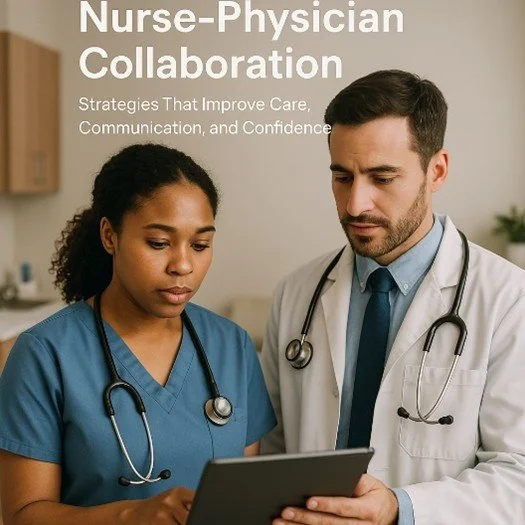Navigating Challenges in Nurse-Physician Collaboration: Strategies for Success
In today’s increasingly complex healthcare environment, collaboration isn’t optional — it’s essential. For nurse practitioners (NPs), working effectively with physicians isn’t just about fulfilling regulatory requirements. It’s about advancing patient care, ensuring safety, and fostering a team dynamic that promotes mutual respect. However, despite its importance, nurse-physician collaboration is often riddled with challenges, from structural hierarchies to communication breakdowns.
In this blogpost, we want to explore why these issues exist and, more importantly, how we can overcome them through evidence-based strategies and a mindset shift that values partnership over protocol. Let’s take a deep dive into the key barriers and solutions that shape successful nurse-physician partnerships.
The Current State of Nurse-Physician Collaboration
The relationship between nurses and physicians has evolved significantly over the decades. What was once a rigidly hierarchical model is now being reshaped by interprofessional care teams, shared leadership, and growing recognition of NP expertise. Yet, old habits and outdated perceptions still linger in many care settings.
Studies have repeatedly shown that strong nurse-physician collaboration correlates with improved patient satisfaction, reduced medical errors, and more efficient workflows. According to the Agency for Healthcare Research and Quality, effective interprofessional communication can reduce patient harm by as much as 30% in acute care settings.
Despite these benefits, collaboration remains inconsistent. Some primary care teams operate with seamless coordination, while others struggle with fragmented communication and unspoken tensions. The variance often stems not from a lack of intent but from systemic and interpersonal barriers that limit the potential of truly cooperative care.
Core Challenges in Nurse-Physician Communication
Communication isn’t just about exchanging information — it’s about interpretation, respect, and timing. One of the core challenges we face is a mismatch in communication styles. Physicians, often trained to prioritize rapid clinical decision-making, may default to concise, top-down communication. NPs, on the other hand, are frequently trained to take a more holistic, patient-centered approach that relies on dialogue. This difference can lead to frustration on both sides.
Hierarchical structures also play a key role. In settings where physician oversight is emphasized, NPs may hesitate to challenge decisions or speak candidly. This dynamic erodes trust and can introduce risk when clinical concerns go unspoken.
Then there’s role ambiguity — a persistent issue in states with reduced or restricted NP practice. When boundaries aren’t clearly defined, responsibilities become blurred. This can lead to duplicated efforts, miscommunication, and (in worst cases) delayed care or patient confusion.
Successful nurse-physician collaboration demands more than proximity — it requires mutual understanding, role clarity, and communication protocols that support partnership rather than supervision.
Organizational Factors Affecting Collaboration
Even with the best intentions, collaboration can falter if the organizational environment isn’t conducive to it. Leadership is the first place to look. Whether it’s a medical director, practice owner, or operations manager, leaders set the tone for how team members relate to one another. If collaboration isn’t modeled or prioritized at the top, it’s unlikely to flourish on the ground.
Workflow design also matters. Shared workspaces and integrated electronic health records (EHRs) can either support or obstruct collaboration. In some practices, NPs and physicians rarely cross paths during shifts due to siloed scheduling or poorly integrated systems.
Policy can also be a hidden barrier. For instance, when policies mandate physician sign-off for minor NP decisions—even in states where an NP collaborating physician can practice independently—they unintentionally reinforce a supervisory dynamic that undercuts collaboration.
Organizational culture may be the most intangible yet impactful element. Institutions that value interprofessional respect, provide platforms for joint decision-making, and celebrate shared successes tend to see stronger outcomes from their collaborative teams.
Evidence-Based Strategies for Improving Collaboration
Fortunately, we’re not starting from scratch. Proven strategies and models exist to bridge the nurse-physician divide and build functional partnerships.
The SBAR (Situation, Background, Assessment, Recommendation) communication framework is one of the most widely adopted. It creates a structured way for NPs to present clinical situations, ensuring clarity and reducing the chance of misinterpretation. TeamSTEPPS, another framework developed by the Department of Defense and AHRQ, focuses on teamwork principles like mutual support and leadership-sharing.
Beyond frameworks, interprofessional education (IPE) is gaining momentum. When nurses and physicians train together, even in simulation, they understand each other’s perspectives and develop a shared language for collaboration.
Another impactful model is shared governance. In this model, NPs and physicians participate in joint decision-making bodies that guide clinical standards and team culture. This reinforces the notion that collaboration isn’t an add-on — it’s embedded in the care delivery structure.
Creating psychological safety is also key. That means fostering an environment where team members can voice concerns, ask questions, and challenge assumptions without fear of ridicule or retaliation. This kind of culture doesn’t just happen — it must be intentionally cultivated.
Implementing Collaborative Improvements in Practice
While theory is important, successful collaboration hinges on its implementation. Nurse practitioners can take the following daily actions to foster stronger partnerships:
Communicate intentionally: Frame issues around shared patient goals, ask clarifying questions, summarize decisions, and express appreciation to build trust.
Implement team-level meetings: Introduce routine huddles or shared care plan meetings to enhance nurse-physician collaboration. Establish simple communication agreements (e.g., response times, preferred contact) to prevent minor frictions.
Prioritize measurement: Track clinical (e.g., patient wait times, referral efficiency, communication errors) and interpersonal indicators. Regularly collect team feedback to assess progress and identify areas for improvement (e.g., "Are we working better together? What has changed?").
Secure leadership support: Advocate for training, protected time for team development, and policies that reinforce the principles of partnership for sustainable collaboration.
At Physician Collaborators, we believe collaboration should be an empowering process, not a bureaucratic burden. If you're a nurse practitioner seeking a better way to work with a nurse-physician collaboration.




